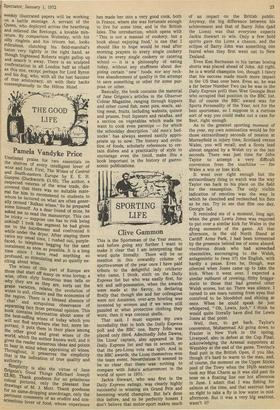THE GOOD LIFE Pamela Vandyke Price
Unstinted praise for two essentials on the shelves of every intelligent lover of wine and food. First, The Wines of Central and South-eastern Europe by E. E. H. Gunyon (Duckworth £1.95). The author,. a respected veteran of the wine trade, discovered that there was no suitable material for him to recommend to students to whom he lectured on what are often generally termed 'Balkan wines.' So he prepared some himself. As a dear friend of mine, he asked me to read the manuscript. This can be tricky — suppose one has to risk being unkind? I took the segment he had given me to the hairdresser and confronted It while under the dryer. After staying there twice my usual time I rushed out, purplefaced, to telephone begging for the next instalment as soon as possible. It is a long time since I have read anything so profound, so stimulating and so quietly exciting about wine. The wines of this part of Europe are those that start off many on wine loving; a wise, often slyly humorous man tells us Why they are as they are, sorts out the grape varieties, relates the evolution of wines to soil, climate and the economics of the region. There is a blessed absence of ' chat ' and scrupulous observance of separating fact from personal opinion. This book contains information about some of the best-selling wines of today which you will not find anywhere else but, more important, it puts them in their place among the other good and great wines of the world, which the author knows well, and it gives the reader numerous ideas and points to bear in mind when appraising all wines. Throughout, it preserves the simplicity that is the indication of true quality and authority. Simplicity is also the virtue of Jane Grigson's Good Things (Michael Joseph £3.80). Thank goodness for no gelatinous colour pictures, only the pleasant line drawings of M. J. Mott. Thank goodness for no name-dropping anecdotage, only the pertinent comments of an erudite and conscientious lover of food, whose experience has made her into a very good cook, both in France, where she was fortunate enough to live for some time, and in the British Isles. The introduction, which opens with 'This is not a manual of cookery, but a book about enjoying food,' is one that I should like to hope would be read after morning prayers to every single cookery class in every single cookery or catering school — it is a philosophy of eating today, without any stuffiness about despising certain 'new' foods, nor any reckless abandonment of quality in the attempt to save something or other for some purpose or other. Basically, the book contains the material of Jane Grigson's articles in the Observer Colour Magazine, ranging through kippers and other cured fish, meat pies, snails, salting meat, fruits, including walnuts, quince and prunes, fruit liqueurs and ratafias, and a section on vegetables which made me want to cook even parsnips — for which the schoolday description 'old men's bedsocks' has always seemed nastily appropriate up to now. The history and evolution of foods, scholarly references to certain dishes and a practicality of style to encourage even the timid, make this a book important in the history of gastronomic publications.














































 Previous page
Previous page